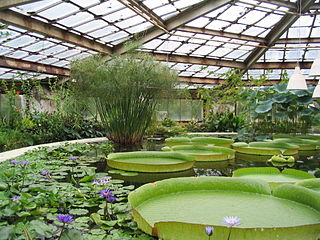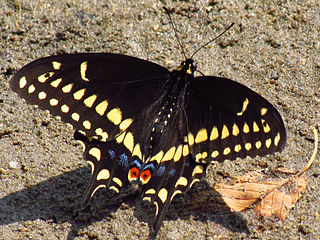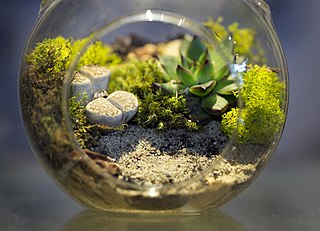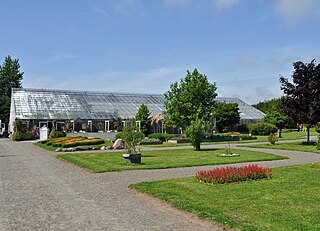
The Cecil B. Day Butterfly Center is located at Callaway Gardens in Pine Mountain, Georgia. It is North America's largest glass-enclosed tropical conservatory. [1]

The Cecil B. Day Butterfly Center is located at Callaway Gardens in Pine Mountain, Georgia. It is North America's largest glass-enclosed tropical conservatory. [1]


The center opened to the public on September 25, 1988 [2] and was one of the first three butterfly centers in the United States. [1]
It was named in honor of Cecil B. Day, a philanthropist and the founder of Days Inn. His wife, Deen Day Sanders, donated artwork and financial assistance to Callaway Gardens in his honor.
The butterfly center is a 7,300-square-foot (680 m2) glass dome that rises to 35 feet at its peak, allowing sunshine inside whenever clouds are absent. The center has received the LEED (Leadership in Energy and Environmental Design) certification award in 2004, which indicates that the building was designed, constructed, and is maintained in ways that are environmentally friendly. [2]
Signs are posted at the exits with a United States Department of Agriculture warning against removing any butterfly, insect or plant material from the premises. Butterflies are considered to be invasive species, requiring a means to prevent "butterfly breakouts". A blast of air is projected inward by a machine at each doorway. [3] Michael Buckman was the manager of the Cecil B. Day Butterfly Center at Callaway Gardens in 2014 and stated, "Butterflies can get sick with viruses and bacterial infections just like humans," said Buckman. "That’s why it’s important to keep the infected butterflies inside so they don’t contaminate our native butterflies and shake up the developed ecosystem." [1]
There are over a thousand butterflies of over fifty different species at different times of the year. [4] Perhaps just as important are the 250 plants of different varieties that produce the nectar that the butterflies feed on. [1]
The conservatory simulates a tropical ecosystem; the temperature is maintained at approximately 80 °F (27 °C) and 74% relative humidity, ideal conditions for the specimens. People will see more butterflies in the Summer because they get their energy from the sun. It could be said that butterflies are solar powered. Insects are cold-blooded, so they won't take flight until their body temperature reaches 80 °F (27 °C). [1]
The theater continuously plays the film, Wings of Wonder, an award-documentary that examines the life-cycle of a butterfly. [2]
The butterfly center buys butterflies from farmers in six countries: Malaysia, Tanzania, Costa Rica, the Philippines, El Salvador and Ecuador. The butterflies are sent to the gardens via US Mail, FedEx or UPS in small cardboard boxes padded with cotton. They are in the pupa stage (chrysalis) when they are shipped to the center. Upon arrival, the chrysalises are pinned to a vertical board and kept in a controlled environment until they emerge. The conservatory usually has one board on display for observation. [1]
In 2005, the Day Butterfly Center underwent a $2 million renovation to accommodate more visitors. [3] The popular iridescent blue Morpho rhetenor emerges in the month of September and several special butterfly events are held. [5]

Metamorphosis is a biological process by which an animal physically develops including birth transformation or hatching, involving a conspicuous and relatively abrupt change in the animal's body structure through cell growth and differentiation. Some insects, jellyfish, fish, amphibians, mollusks, crustaceans, cnidarians, echinoderms, and tunicates undergo metamorphosis, which is often accompanied by a change of nutrition source or behavior. Animals can be divided into species that undergo complete metamorphosis ("holometaboly"), incomplete metamorphosis ("hemimetaboly"), or no metamorphosis ("ametaboly").

A greenhouse is a special structure that is designed to regulate the temperature and humidity of the environment inside. There are different types of greenhouses, but they all have large areas covered with transparent materials that capture sunlight and heat. The most common materials used in modern greenhouses for walls and roofs are rigid plastic made of polycarbonate, plastic film made of polyethylene, or glass panes. When the inside of a greenhouse is exposed to sunlight, the temperature increases, providing a sheltered environment for plants to grow even in cold weather.

A pupa is the life stage of some insects undergoing transformation between immature and mature stages. Insects that go through a pupal stage are holometabolous: they go through four distinct stages in their life cycle, the stages thereof being egg, larva, pupa, and imago. The processes of entering and completing the pupal stage are controlled by the insect's hormones, especially juvenile hormone, prothoracicotropic hormone, and ecdysone. The act of becoming a pupa is called pupation, and the act of emerging from the pupal case is called eclosion or emergence.

Papilio polyxenes, the (eastern) black swallowtail, American swallowtail or parsnip swallowtail, is a butterfly found throughout much of North America. An extremely similar-appearing species, Papilio joanae, occurs in the Ozark Mountains region, but it appears to be closely related to Papilio machaon, rather than P. polyxenes. The species is named after the figure in Greek mythology, Polyxena, who was the youngest daughter of King Priam of Troy. Its caterpillar is called the parsley worm because the caterpillar feeds on parsley.

A conservatory is a building or room having glass or other transparent roofing and walls, used as a greenhouse or a sunroom. Usually it refers to a space attached to a conventional building such as a house, especially in the United Kingdom. Elsewhere, especially in America, it can often refer to a large freestanding glass-walled building in a botanic garden or park, sometimes also called a palm house if tall enough for trees. Municipal conservatories became popular in the early 19th century.

A vivarium is an area, usually enclosed, for keeping and raising animals or plants for observation or research. Water-based vivaria may have open tops providing they are not connected to other water bodies. An animal enclosure is considered a vivarium only if it provides quality of life through naturalistic components such as ample living space and natural decor that allow and encourage natural behaviours. Often, a portion of the ecosystem for a particular species is simulated on a smaller scale, with controls for environmental conditions such as temperature, humidity and light.

The Atlanta Botanical Garden is a 30 acres (12 ha) botanical garden located adjacent to Piedmont Park in Midtown Atlanta, Georgia, United States. Incorporated in 1976, the garden's mission is to "develop and maintain plant collections for the purposes of display, education, conservation, research and enjoyment."

Fairchild Tropical Botanic Garden is an 83-acre (34 ha) botanic garden with extensive collections of rare tropical plants including palms, cycads, flowering trees, and vines. It is located in the city of Coral Gables, Miami-Dade County, just south of Miami, surrounded at the north and west by Matheson Hammock Park.

Phipps Conservatory and Botanical Gardens is a botanical garden set in Schenley Park, Pittsburgh, Pennsylvania, United States. It is a City of Pittsburgh historic landmark and is listed on the National Register of Historic Places.

Reiman Gardens is a 17-acre (6.9 ha) university-owned public garden located immediately south of Jack Trice Stadium on the Iowa State University (ISU) campus in Ames, Iowa. Reiman Gardens is a year-round garden with events, programs, lectures, and tours that has consistently been one of the top visited attractions in Central Iowa.

Callaway Resort & Gardens is a 2,500-acre (1,000 ha) resort complex located near Pine Mountain in Harris County, Georgia, 18 miles (29 km) from LaGrange, Georgia. The world's largest azalea garden, this destination draws over 750,000 visitors annually. Callaway Gardens was ranked as Best Georgia Attraction in 2018 by USA Today.

The Victoria Butterfly Gardens is located in the Greater Victoria region of Brentwood Bay, British Columbia, Canada. It is one of the most popular tourist sites in the Victoria area. The Victoria Butterfly Gardens are known for having different species of butterflies and moths in their indoor facility, as well as birds, fishes, frogs, an iguana, geckoes and tortoises, along with the newly added Insectarium. The Gardens is closed Christmas day.

Morpho peleides, the Peleides blue morpho, common morpho or the emperor is an iridescent tropical butterfly found in Mexico, Central America, northern South America, Paraguay and Trinidad. Most authorities believe that peleides is a subspecies of Morpho helenor.
Cecil Burke Day was an American hotelier, known for founding the hotel chain Days Inn.

Butterfly World is located in Tradewinds Park in Coconut Creek, Florida. It opened in 1988, and it is the largest butterfly park in the world, and the first park of its kind in the Western Hemisphere. The facility houses around 20,000 live butterflies.

The Butterfly Pavilion is located in Westminster, Colorado. It opened on July 15, 1995, and was the first stand-alone non-profit insect zoo in the United States. The 30,000-square-foot (2,800 m2) facility is situated on 11 acres (4.5 ha) of land, and contains five main exhibit areas to teach visitors about butterflies and other invertebrates. The main exhibit is an indoor rain forest filled with 1,200 free-flying tropical butterflies.

Bornholm Butterfly Park is located on the western outskirts of Nexø on the Danish island of Bornholm. Over a thousand brightly coloured butterflies from around the world can be seen in a large former hothouse while wild Danish species abound in the flowery garden.

A butterfly house, conservatory, or lepidopterarium is a facility which is specifically intended for the breeding and display of butterflies with an emphasis on education. They may also be used to support local populations through butterfly release. Some butterfly houses also feature other insects and arthropods. Butterfly houses are owned and operated by zoos, museums, universities, non-profit corporations, and private individuals as part of their residence; as well as small businesses that are owner operated.

John A. Sibley Horticultural Center was a 5-acre (2.0 ha) greenhouse and conservatory within Callaway Gardens located near Pine Mountain in Harris County, Georgia, United States, 18 miles (29 km) from LaGrange, Georgia. Callaway Gardens promoted it as "one of the most advanced garden/greenhouse complexes in the world".